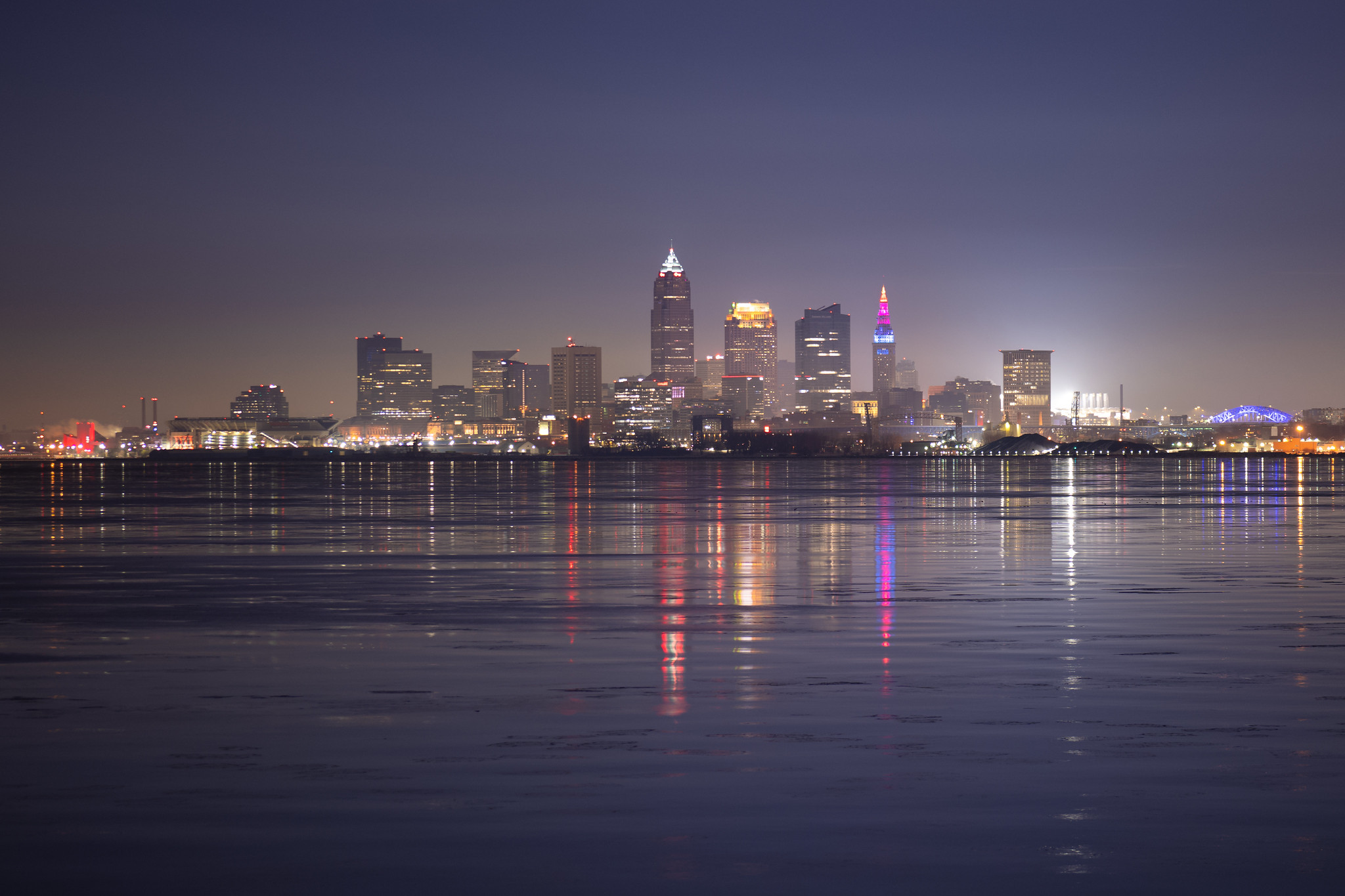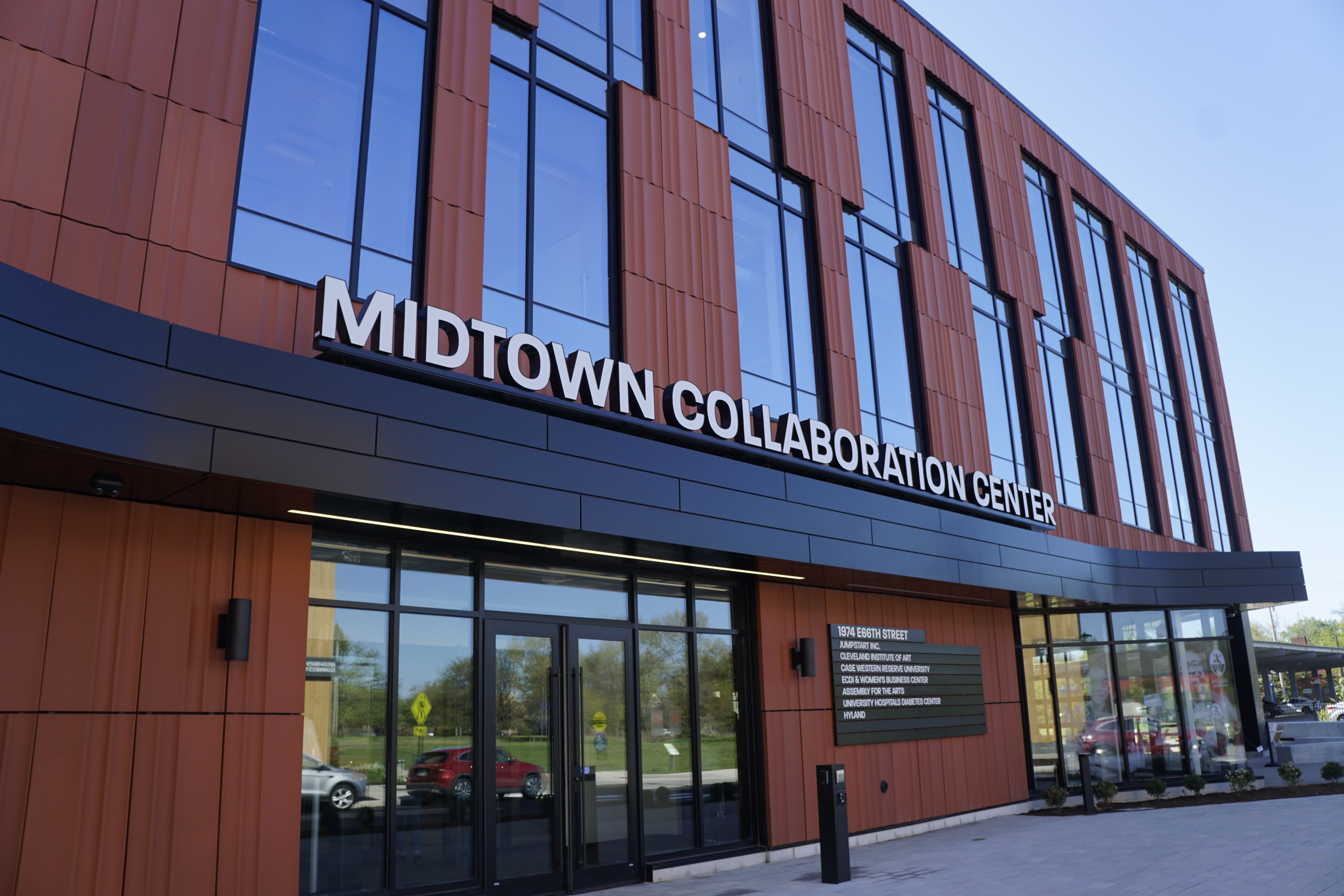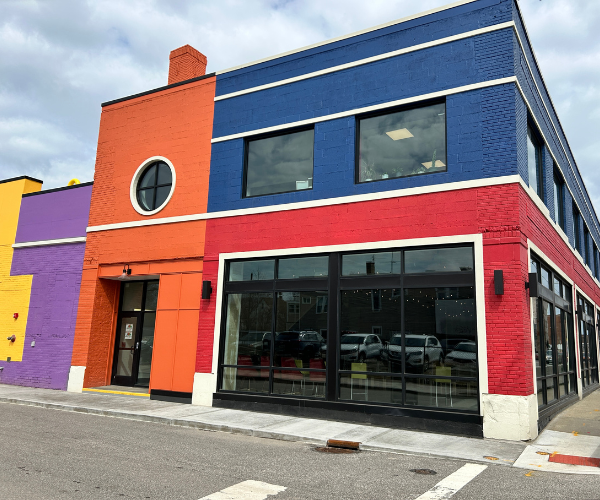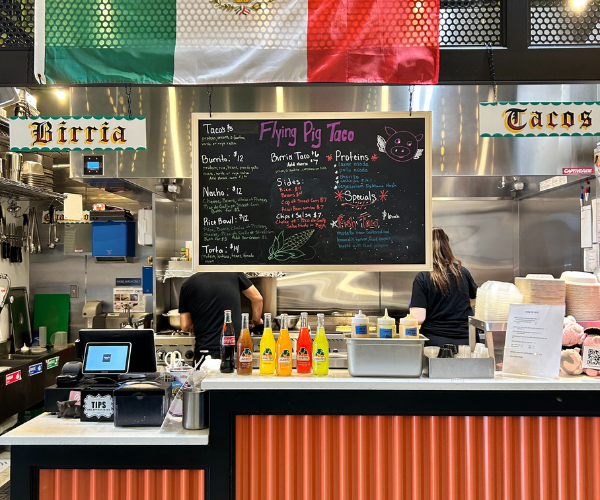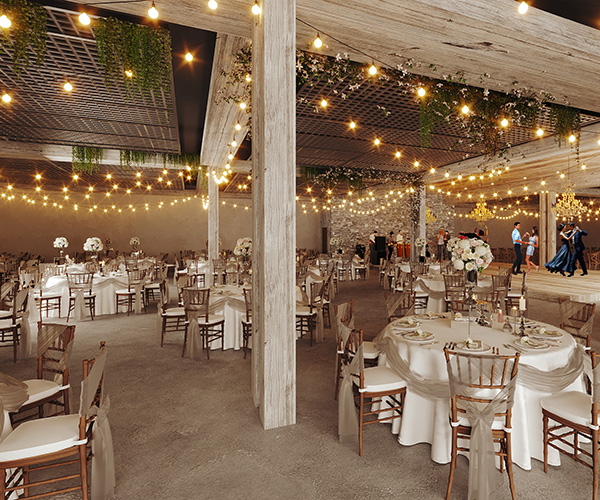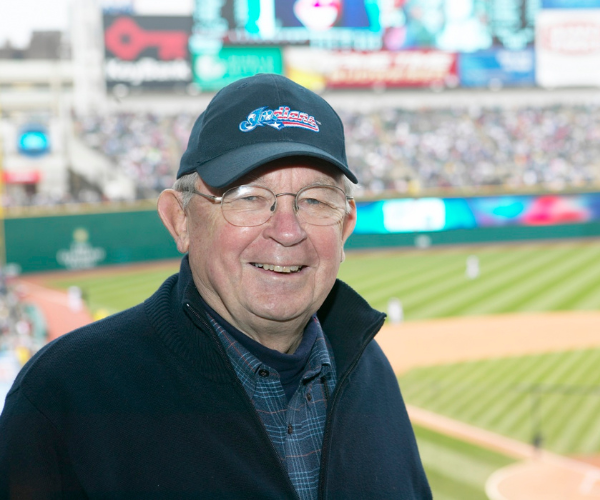Glenville's Apartment By The Park
by Sheehan Hannan | Feb. 12, 2019 | 1:00 PM

PHOTOGRAPHED BY ANGELO MERENDINO
For many years, near East 105th Street and Ashbury Avenue, there stood a cottonwood tree. It grew and grew and grew, close to the back wall of an art deco-style gas station until, with its offspring, it made the boarded-up building a piddly little thing, swallowed by a puddle of mighty shade. When the wind swished, the oval leaves conjured the rain.
Then the men in hard hats came in their pickups, with their blueprints and notions of progress and cut the tree down. Their backhoes toppled the gas station and churned the urban farm next door, until where the tree rooted was blank. And the hard-hatted men could begin again.
Julie Ezelle-Patton watches them from the dining room table of her third-floor Glenville apartment. A poet, she wears a roughly sewn blue sweater and an orange and blue head wrap that makes her appear at least 6 inches taller.
We spoon at oatmeal, served by building manager Arcey Harton, and sip lapsang tea from earthenware cups as the workers stomp about on a muddy lot bordered in chain-link fences.
For months, the lot behind Julie’s apartment block has been a buzzing hive as a four-story complex of 63 apartments and storefront retail rises. Expected to be complete this spring, Circle North extends for almost an entire city block.
To Julie, it is a blinking danger sign. She grew up in this part of Glenville. She dropped off papers for her brother’s Plain Dealer route along East Boulevard and spent evenings collecting leaves and watching baseball games at Gordon Park.
She honed her poetry with students of Russell Atkins, trading verses on the porches of Olivet Avenue, while her mother painted in the kitchen inside.
Julie channels that community memory into her art, layering new work onto the old, drawing materials and inspiration from her family, the trees, the buildings. Now that world could change in ways she doesn’t recognize, through the wrecking ball, the excavator and the crane.
But Julie does not fear just for herself. For years, she has tended and lived inside one of the Cleveland art world’s best-kept secrets, a haven for artists, musicians, poets and Bohemians.
Outside, it is camouflaged, one of 12 red brick structures along East Boulevard, across the street from the jogging paths and rustling treetops of Rockefeller Park. Its entryway is like so many others on the East Side, a simple number perched atop a concrete prewar arch.
But inside, the eight apartments have hosted a miniature Harlem Renaissance. Since Julie bought shares in an apartment there in 1987, she has maintained the building as an ongoing art project. Part residence, part community center, part arts incubator, it morphs and re-forms, harmonizing with the artistic needs of whomever has taken up residence.
“This is University Circle, squared,” Julie says. “We have music, we have natural history, we have a botanical garden, we have art and we have history going back to the 19th century.”
Dozens of creative people, in the rising action or denouement of their careers, have passed through its walls: RA Washington, Daniel Gray-Kontar, Marjorie Witt-Johnson and Nina Sarnelle. They slept on its couches and held salons in its living rooms, grew food in its garden and hung paintings in its basement.
“We’re basically caretakers of these legacies, with the hope of keeping them safe,” Julie says.
The building also acts as an archive. Its walls are adorned with drawings. Its stair landings are laden with installations. Its apartments are stuffed with canvases. But its most recent acquisition is, for Julie, a personal one.
Inside the building, she showed several hundred paintings in an exhibit titled Womb Room Tomb during last year’s Front Triennial.
Her mother, Virgie Ezelle-Patton, had a local career spanning more than seven decades. But in that time, she received little recognition from Cleveland’s art world. In her life, she had one major solo show. After Virgie died, Julie assembled hundreds of her canvases, drawings, journal pages and sculptures into an apartment-wide art installation as a living legacy to the mother she loved deeply.
After breakfast, Julie and Arcey take me on a tour of the back bedrooms, which they keep available for artists, such as LA-based poet Will Alexander. In one room, someone has penciled a freehand mural of the Cleveland skyline on the wall. Pennies are glued in a row by the footboard.
But first, we go through a door in the other bedroom and emerge onto an enclosed balcony looking out over the construction site. The cinder blocks have risen almost to our level as we stand on the third floor. A gray tarp flaps in the chilly wind.
Soon the four-story development will climb higher even than us, higher than the cottonwood’s branches ever reached.
As we turn inside from gazing at the construction, Julie stops to deliver a foreboding prophecy, a dark echo reflected in Womb Room Tomb.
“This is the death of a project,” she says, warming in the bedroom, “and the artists
associated.”
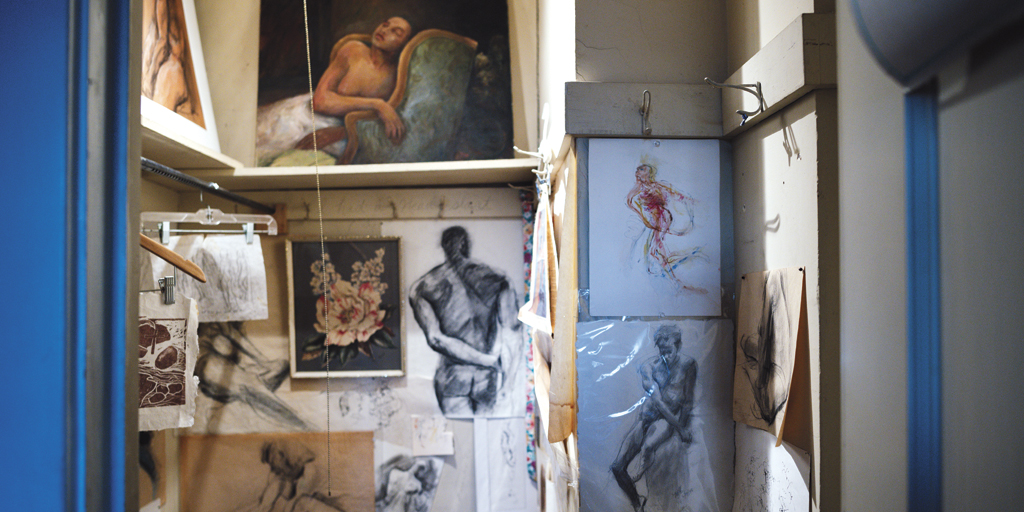
Julie clomps down the stairs to Womb Room Tomb.
An entire lifetime of work is compressed into more than 1,200-square-feet. Sunshine streams through the south-facing windows of the large apartment, but the sheer quantity of art makes the space appear small. Virgie’s paintings hang in the living room, dining room, kitchen and four bedrooms. Her busts and sculptures are placed strategically in corners, the three-dimensional female figures arranged next to the paintings they inspired.
The walls of one large walk-in closet are papered with pages from Virgie’s journal, and the shelves are filled with photographs, mementos and sketchbooks. A few drawings can even be found in the bathroom.
In the dining room, Pen Pals depicts a luscious classical nude lying as if on a couch, hovering against a sunset-dappled background. In the foreground float miniatures of the works from which Virgie drew inspiration: classical colonnades, faithfully represented Picasso nudes, African statues and nude, dark-skinned dancers like ones on a Greek vase.
Right beside them, Virgie painted her self-portrait, an assertion that she was not just inspired by the greats of history — she was one of them.
Born in 1928 as Virgie Ezelle, she was recognized early by her teachers for her potential. One summoned Virgie’s mother to Quincy Elementary School on a rainy day to see her watercolors spread out on the floor, as proof of the 5-year-old’s talent. When her art teacher at John Hay High School sent her to Saturday classes at the Cleveland Museum of Art, Virgie went without questioning.
Her artistic career seemed predestined. While she never received a formal college degree, Virgie obtained her education in other ways.
A child of the Great Depression, who recalled standing in lines for staples, she created her own curriculum. Even after marrying Cleve Patton and raising six children, she took classes at the John Huntington Polytechnical Institute, the Cleveland Institute of Art (where she received an honorary degree in 1994), the Cooper School and Karamu House. She took lessons from the great artists of the Cleveland School, such as painter Paul Travis.
Virgie also became a well-known figure in Cleveland’s artistic scene, with a studio in the Artcraft building and friends such as Atkins, CIA’s first black graduate Charles Sallee and the legendary black stained glass artist Douglas Phillips.
Along the way, Virgie drew from Travis’ leaping, colorful palette, and the splashy abstractions of Robert Rauschenberg and Jasper Johns. But the journey was, she once told an interviewer, very difficult.
After high school, she took a job at American Greetings, becoming one of the first black artists to work there. A few years later, she left to raise her family, sneaking in painting sessions around her children’s schedules.
“No one could keep me from painting,” she recalled. “I was even pregnant while I was in art school.”
Virgie’s midlife was perhaps her most productive period. Many of the canvases Julie now stewards date from the 1980s and 1990s. By the 2000s, Virgie’s health was waning from a decadeslong battle with lung sarcoidosis. Stuck in bed, she painted her vanity and her children — the things on which she most often laid eyes.
She received hospice care at the East Boulevard apartment and died March 17, 2015. Her home in South Euclid was foreclosed on, and Julie, with her siblings, rushed to save her work. Since then, Julie has spent the years sorting through it, filling the apartment with Virgie — a living womb and a tomb.
In the process, Julie took a few prized pieces for herself. On the wall by the door upstairs, Virgie made Julie look like a queen. A leopard-print dress wraps around her short but mighty frame, embellished by a fur overcoat and hat, and pearl earrings. Her two cats, Smokey and Puddin Tane, sit at her feet, a coy and ferocious royal guard.
Virgie created the painting in 2001, when Julie came back to Cleveland from New York to teach a semester of creative writing at Case Western Reserve University. With family living temporarily in her apartment, Julie stayed with Virgie in South Euclid and brought the cats. Virgie was delighted.
Julie grows wistful as she gazes at it, one hand to her mouth and the other on her hip. “If something happens to me tomorrow, this work is gone,” she says. “Why didn’t the city or the Cleveland Museum of Art or someone care?”
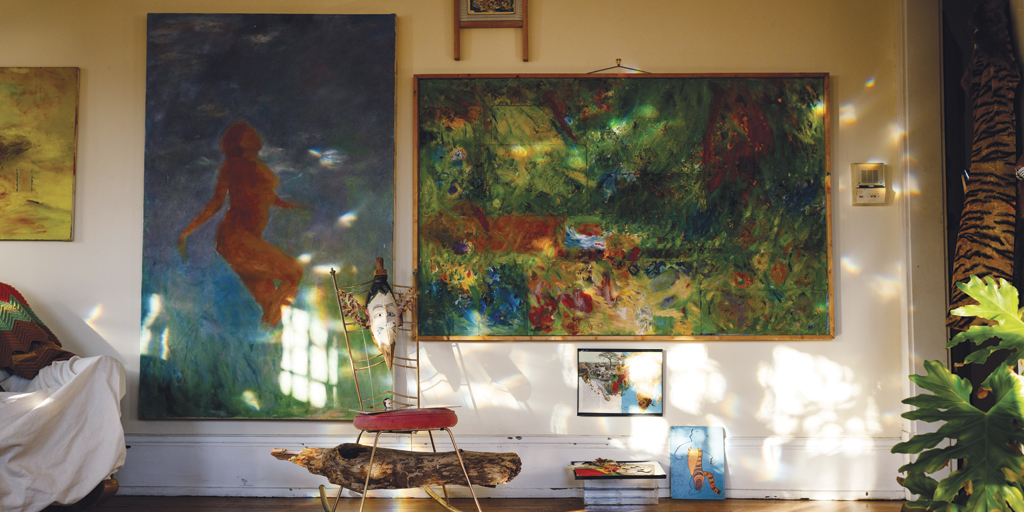
Growing up with an artist mother, Julie intended to never become one.
In the Olivet house, two doors down from East 105th, Virgie would paint in the kitchen, her oils staining the porcelain sink. Julie associated the smell of raw chicken with turpentine and became a vegetarian at 8.
“With six children, we lived in a two-bedroom house on Olivet. There were six kids, cats, a dog,” Julie says. “And she painted in that house.”
Julie gravitated to political science far from home. But she dropped out of Boston University after one semester. “[With] what I wanted to say and do, the arts actually allowed more freedom,” says Julie. “So I stopped rebelling.”
She transferred to Antioch College, the tiny liberal arts school in Yellow Springs, Ohio, where she studied art and wrote poetry. The real attraction was the surrounding woods and semesters studying abroad in Europe.
During the summers, Julie returned to Cleveland and taught art classes in city recreation centers and photography at the Friendly Inn Settlement. In 1979, after her graduation, Julie got a job with the Dayton City Beautiful council, where she worked with artists such as sculptor Tom Doyle on site-specific installations. It was the only time in her life she has collected a full-time salary.
Julie moved to New York to pursue art and poetry, first from a loft above a bar on Broom Street in SoHo and then, in the 1980s, in the East Village. She had arrived at a blossoming moment and dove headlong into the scene centered on the Nuyorican Poets Cafe.
She began to split her time between New York, Europe and Cleveland, going wherever there was money between teaching jobs, residencies and gigs to support her work.
In 1987, she moved into an apartment in the building on East Boulevard. She was familiar with it from her youth, and her friend Ted Sherron, then-director of admissions at the Cleveland Institute of Art, had shown art in his apartment there.
Julie joined an artistic legacy there that, it turns out, runs as deep as its foundation. Herman Wolfe, an entrepreneur from Chicago who owned Wolfe Music Co., a seller of pianos and phonographs, constructed it in 1913. An ad in The Plain Dealer that year bragged of its “interior finish mahogany oak and white enamel.” Units were apparently going quickly. Half were already sold.
In the following decades, the Glenville area became the center of Cleveland’s Jewish community, and several residents of the building announced the weddings of their children at local synagogues.
As historian Todd M. Michney records in his book Surrogate Suburbs, by the 1940s African-American professionals were moving to Glenville, and the large houses and sun-soaked apartments along tree-lined East Boulevard were among the area’s most attractive.
The swaying boughs of Rockefeller Park just across the street and access to University Circle close by may have been the reason two doctors and a social worker purchased the building in 1949. Leon Evans, Martin Crawford and Wennona Reynolds acquired the building for $48,500 and set up a cooperative to govern its ownership as a collective.
Around that time, Cleveland Indians outfielder Larry Doby was said to have had an apartment there.
Evans, a distinguished physician known for having diagnosed the first case of Addison’s disease in Cleveland, retired there in 1968 to pursue his hobby — painting.
Marjorie Witt Johnson, a contemporary dance choreographer, lived there too. In 1935, she created the Karamu Dancers and took them to the 1940 World’s Fair in New York, a seminal event that marked the emergence of Karamu House as a center for young, talented black dancers. By the 1990s, she was in her 80s.
So it must have been a shock when Daniel Gray-Kontar sublet Julie’s apartment in 1995, bringing with him several brash Cleveland State University students. The apartment became a hangout for the Black Poetic Society where they talked about writing, held poetry readings and playwriting workshops, and listened to rap, hip-hop and jazz records.
“It was very fertile,” says Daniel, who went on to found Twelve Literary Arts, an organization that fosters Cleveland’s young poets. “That was a very fertile time for the black literary arts in Cleveland.”
RA Washington stayed there for about a year too. His mentor and friend, the poet Austin Allen, headed the co-op in the building next door, and RA would hop between Austin and Daniel’s apartments, sleeping on couches, eating and sneaking books.
“It’s when I maybe transitioned from a young person attempting to write, to being a writer,” RA says.
Writers and performers were always circulating in and out, holding salons or visiting. The neighbors complained to Julie about the rap music pulsating from her apartment on a block that had a reputation for quietness. But to RA, the environment was electric.
“It was the closest I ever felt to being in Harlem and going to the Harlem Renaissance or something like that,” he says.
In 2007, Johnson died, and Julie realized she had to do something. In some of the 11 other apartment buildings along East Boulevard, co-ops were collapsing and converting to condominiums as older residents died.
With the help of lawyer and arts patron Lee Chilcote, she formed Bluestone Circle, a limited liability corporation named for a type of rock sometimes found down the hill in Doan Brook, and got ownership of the building transferred to it.
On paper, Julie was in sole control of the building. But she wanted to keep it, at least in spirit, owned by the community. So she created a list, which she continues to maintain. Anyone who comes through the building and contributes to its future, through money, art or just plain sweat, becomes an unofficial shareholder and co-owner.
“I was like, ‘I don’t want to own the building. Let me steward it,’ ” Julie says. “We’re just stewarding it until we can figure out what to do, how to deliver it into the hands of another generation.”
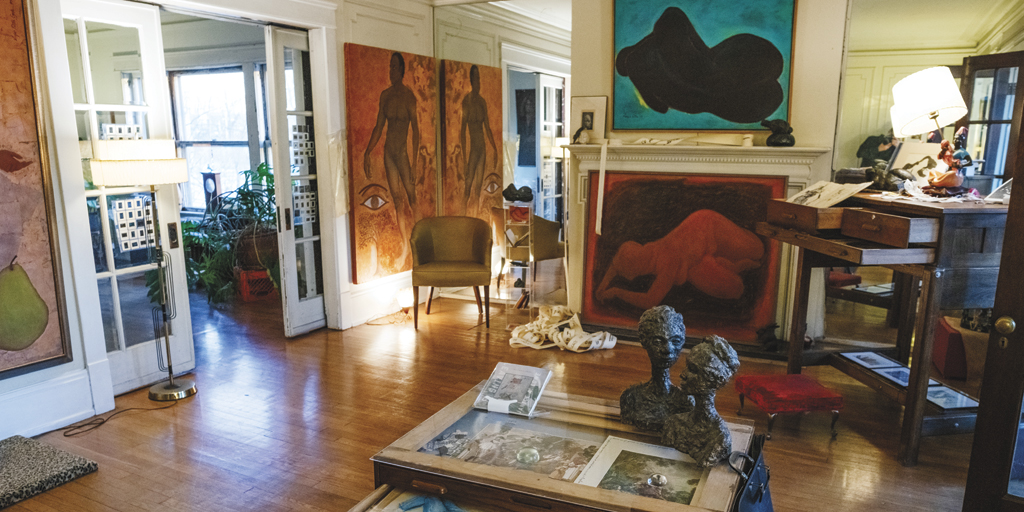
In 2006, Ian Charnas, fresh out of Case Western Reserve University with degrees in computer science and mechanical engineering, found himself needing a place to live.
At the time, he was interested in urban farming, and a friend put him in touch with Julie. He came, toured the building and the lot next door where Julie tended mulberry bushes, and moved in. The apartment’s large fireplace, wood floors, luscious trim and the open patch of greenery outside were all part of the appeal. But so was Julie.
“She’s like the Mary Poppins of the art world,” says Ian. “She just pops in, floats down out of the air and is suddenly in the right place at the right time for very cool things to happen.”
Ian’s day job creating websites and apps wasn’t overly challenging, and Julie seemed to say yes to any projects he might think of. He thought up and assembled the Tesla Orchestra, two giant Tesla coils that throw zaps of electricity between them to make music.
He also turned his engineering knowhow to the building, fixing the steam boiler and turning a former basement coal storage room into a small movie theater.
“For Julie, really nothing is impossible,” says Ian. “If I learned any lesson from her, that would be it.”
They also teamed up to create the Green Scouts, an ad hoc summer program for neighborhood kids. Many came from the Park Place apartments across the street, which has a reputation for poor living conditions.
With a $5,000 Neighborhood Connections grant, they took them on field trips, planted spinach and tomatoes in the next-door lot, showed films and read books about ecology, and canned mulberry jam.
In a neighborhood where fruits and vegetables can be difficult to obtain without a drive, even a trip to an orchard could be an educational experience. “One of the kids didn’t want to eat the peaches, because he said, ‘It comes from a tree, it’s dirty,’ ” Ian recalls. “ ‘Peaches come from a store.’ ”
For a young college graduate from Brecksville, living in Glenville was a transformational experience. Ian met artists, like Virgie and the filmmaker Alison O’Daniel, and others from New York, Chicago or Los Angeles who seemed to constantly filter through the two free bedrooms in Julie’s apartment. “It was like a personality cabaret,” he says.
In 2008, Nina Sarnelle moved in. After graduating from Oberlin College, she had jetted off to New York but returned to Cleveland dejected. Responding to a Craigslist ad for a roommate, Nina moved in with Ian.
At the time, she didn’t consider herself an artist. But living in the building, helping out with the Green Scouts and meeting Julie and Arcey brought out her creative potential. She and Julie created Salon des Refuses, an art gallery in the basement of the building, named after the infamous 1863 showing of works rejected from the Paris Salon.
To finance it, they held a vegan chili cookout, to which 200 people showed up with a $10 suggested donation in hand. With their support, she put on her first art show at the Salon des Refuses.
“It was just this attitude of, like, Oh you don’t have a gallery to show your work? Just make one,” says Nina. “That was the kind of attitude that was pretty transformational to me, ’cause at the time I was honestly kind of depressed and unsure.”
After two years, Nina left for graduate school in Pittsburgh. Since, she has had a successful solo career creating installations and music. She has also been part of several collectives, including The Institute for New Feeling, which was included in a 2017 exhibit at the Museum of Contemporary Art Cleveland.
Nina’s time at the apartment, taking part in the community Julie had fostered, inspired confidence in her work.
“I just felt like, all of a sudden, I can make a difference. I can really create the thing that I want,” says Nina. “There’s space and free resources, essentially, there.”
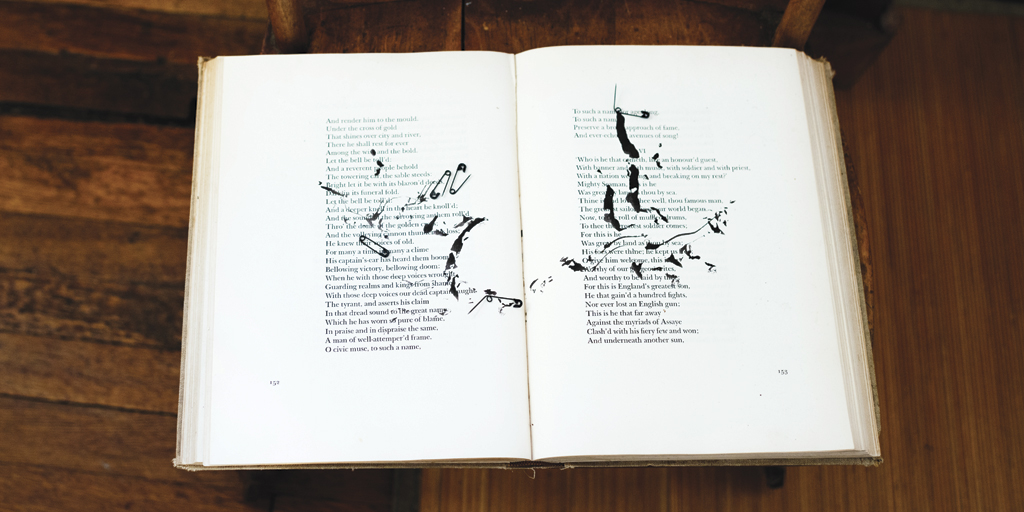
Just as Virgie claimed mastery in her paintings, Julie’s work claims her mother.
Hanging above the fireplace is a telling example of Virgie’s work, a figure resting on a rippling teal background. Seen from behind, in a fetal position, her head and neck are obscured by the severe arch of her shoulders, her spine and buttocks contorted into a shape like the curve of the letter U. Her skin shimmers charcoal-black.
The female body was the defining subject matter of Virgie’s career. She always returned to it. In a 2008 interview with Sharon Dean, then-director of the Cleveland Artists Foundation, Virgie said she would paint the background first, and the body would seem to emerge from the canvas.
In another interview, she said the compressed forms were a statement on the demands of femininity and motherhood.
“I would select from my drawings things where the body was contained within itself, not outstretching arms and things. I came up with a series of paintings and the more I thought about what I was doing, the more I realized I had a theme,” Virgie said. “They were all women. And it was different. It was me. It was my own.”
Much of Virgie’s work is preoccupied with that question: What could she claim as her own? Perhaps that is why she so often painted her daughters.
On one canvas, hanging on a bedroom wall, Julie, Jennifer and Michele lounge in an abstract expressionist’s idea of a living room, one reading and the others staring off.
In another, Virgie painted Jennifer alone, sitting in a chair. She looks half asleep, luxuriously slumbering, her eyes closed and elbow propping up her head. All of them have the same dreamy quality, outlined lightly and swimming on the canvas.
“She always said, ‘I can paint figures in my sleep,’ ” Julie says. “ ‘Why do I want to draw them realistically?’ ”
When portraying Virgie, Julie takes the same tack. The 2007 poetry collection Using Blue to Get Black is framed as an extended conversation between mother, daughter and nature. In the first few lines, Julie makes the connection between them explicit.
“Primer: Shoulda seen the lake today!
Water so still almost as if sky conjured up a mirror to sea
itself bird ducking and divin’ off sudden
glimpse of themselves
take off on blue notes…ink’d in
conversationsilhouette
Mother daughter tit for tat…”
Although their work often diverges (nature appears rarely in Virgie’s work, but is a constant in Julie’s), one thing unites mother and daughter: under-recognition. Virgie never got her due from Cleveland’s art scene. Julie, too, has found more of an audience for her poetry, which is often categorized as avant-garde, in South America and Europe.
“I am in the same boat as her. Russell [Atkins] got lost. I got lost. My mother’s work got lost,” Julie says, as we pause in the hallway of Womb Room Tomb. “The market sees you only if you talk about your identity.”
No one could deny Virgie’s abilities. But over a professional career of more than seven decades, she only had a handful of small solo shows and was most often shown in groups. The William Busta Gallery hosted her first major private solo gallery exhibition in 2013, two years before she died.
“She would always say that while she painted and drew and everything else from her own experience, and that was an experience as a black woman,” says gallery owner William Busta, “she would also say that she didn’t want to be identified as a ‘black artist.’ She wanted to be identified as an artist.”
Virgie also worked on the same paintings over decades, he says, which meant she had little new work to show in any given year. Twice in her career, she lost large bodies of her work, once to a fire and again to theft.
“She remained committed to the figure throughout her whole career,” says Cleveland Arts Prize winner and painter Don Harvey, a friend and peer who helped organize the 2013 show. “That commitment probably cost her public attention in Cleveland.”
Another reason, Julie says, was because Virgie resisted the easy classifications institutions wanted to fit her into. The group shows that included her were often billed as collections of African-American artists or African-American art.
But Virgie wanted no such labels. “It’s so limiting,” she once said, pushing against any effort to dictate her style or subjects.
In particular, she wanted nothing to do with politics driving art and was uncomfortable with the politically infused aesthetics of black nationalism, which in the 1970s was suffused through the Karamu House scene. If white tastes could not tell her what to paint, black ones could not either. “I’ve always felt this need to express myself as a universal artist first,” Virgie told the journal Callaloo.
“There’s more than one way to be political in the world. You can be political in a community by creating artists’ space, like my mom did, or by extending education through the arts, like she did,” says Julie. “But at home, she was interested in color.”
In her attic studio in South Euclid, where she worked in later life, surrounded by canvases, busts and drawings, Virgie claimed the freedom of those old masters on the art museum wall, of Rauschenberg and Johns, and with every stroke enacted her particular artistic will. A rigorous will. A black will. A female will. A motherly will. But Virgie’s will first.
It is that will, her mother’s free-ranging and self-determined way of creating, that Julie is trying so hard to preserve.
In the kitchen, Julie painted around one of her mother’s landscapes from the 1960s, extending the blots of ochre and swirls of yellow from the canvas onto the apartment wall.
Images of a Cleveland fall painted in the 1960s by her mother’s hand, and Julie’s, spill forth in a collage of creation and destruction: torn bits of wallpaper, a pattern of ripened pears from decades past, slivers of bark, clippings of birds and flowers, and rich oil paints.
Mother and daughter entwine on the apartment wall, as, periodically, the building shakes from the work site next door.
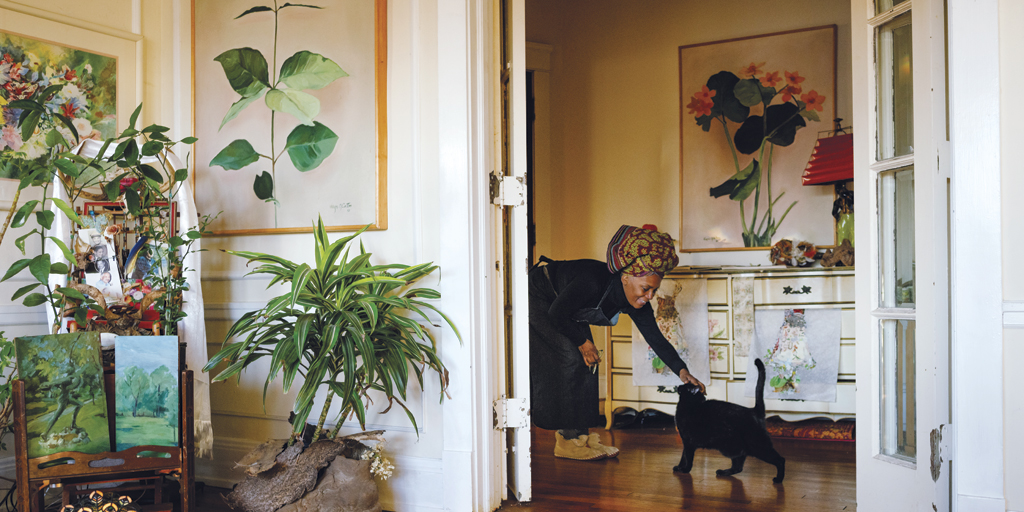
Outside Womb Room Tomb, we go down another flight of stairs, past a landing where blackboard paint has been slathered on the walls. Visitors scribbled and drew chalk greetings: a scalpel with “A surgeon was here,” “Jaralynn & Jack,” “Zara was here” and “A todo ritmo!!”
We pass the door to another apartment. Inside, says Julie, are thousands of canvases, prints and drawings by Theresa Ramey, an artist and friend of Julie’s who died in 2017. Iron bars cover the door.
“This was the Glenville museum, in my mind. We can’t call it that, because it’s not zoned for that,” says Julie as she descends. “But it’s the Glenville artists collection.”
We head into the basement, to the bathroom of the Salon des Refuses, where a fluorescent orange and green canvas is perched on top of the toilet. Large graphic prints are hung on the shower wall and propped in the tub. Both are by Leonard Mainor, a painter and photographer from Glenville. Part of the mission of the building, says Julie, is to try to save the work of her mother’s colleagues too.
But that could soon become challenging. Although it is located in the heart of the city, the building was always a quiet place where writers and poets had space to think, free of televisions and noise.
To Julie’s exasperation, the construction has turned up the volume. Drilling periodically shakes the building. The incessant beeping of trucks begins just before 7 a.m. most mornings and continues into the evening. When the new building is complete, it will deposit cars from its parking lot into the alley behind.
The more than $15 million project is part of Mayor Frank Jackson’s Neighborhood Transformation Initiative, which is intended to prompt private investment in struggling Cleveland neighborhoods.
The initiative’s first project, Circle North is already living up to its aims. Crain’s Cleveland Business reported last October that a private developer had acquired 10 sites in Circle North, also the rebranded name of the area, for houses costing more than $250,000. Five had already been sold.
New pastel-toned condo buildings seem to sprout every day along East 118th Street. On the other side of East 105th Street from the Circle North project, more trucks are constructing a new building for the Veterans Affairs Hospital.
“It seems like University Circle has been expanding outward,” says Paul Van Curen, a jazz guitarist and professional real estate appraiser who has lived in the building for 10 years and plays gigs with Julie. “That’s basically what that building behind us is. It’s a beachhead.”
For politicians and developers, a changing neighborhood is a success story. But Julie and her friends worry about the consequences for the building. Its taxable value spiked suddenly last year by more than 50 percent, the highest level since 2007.
In 2019, Julie expects to pay $1,408 more in property taxes than she paid in 2018, no small sum for a poet who has taken a “vow of povArty.”
“We’re probably eventually going to have to go somewhere else,” says Paul.
It is a future to which Julie has resigned, as we talk, standing in the white-walled black-floored basement that was once a gallery.
“We decided to fail right along with the community, to be honest. Because that would be the just thing. Not the I’m-gonna-get-mines-and-have-more. There’s no hard-centered-ness in that,” Julie says. “So if we have to disappear, well, hey.”
She throws up her hands, spent.
“Well, I just said enough.”
Beside her, a large figure painting of Virgie’s hangs on the wall, a woman on a mustard background. She is just a torso, hopping on one extended leg, headless and armless, her other leg severed or bent from the viewer at the knee. Her skin is inky. You have to look very closely, almost with a magnifying glass, to make out the delicate gray of her shoulder blades and the curve of her spine.
It takes some further looking, but after a while one thing becomes certain: She is in motion, hobbling toward some thing or place she cannot see or hear or touch. But moving nonetheless.
For more updates about Cleveland, sign up for our Cleveland Magazine Daily newsletter, delivered to your inbox six times a week.
Cleveland Magazine is also available in print, publishing 12 times a year with immersive features, helpful guides and beautiful photography and design.
Trending
-
1
-
2
-
3
-
4
-
5

